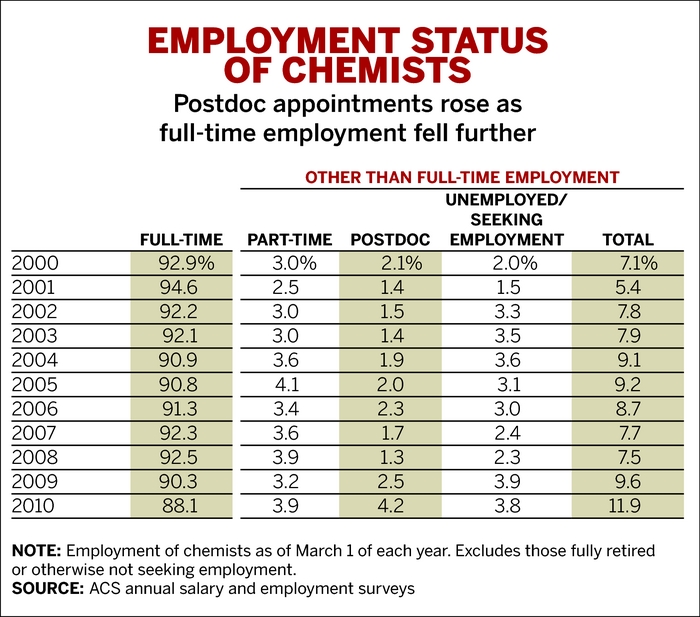 |
| Credit: Chemical and Engineering News |
It's going to take a while to wade through all the data, but here are the important details (to me, anyway):
- Reported salaries were all down, with the exception of median B.S. chemist salaries.
- As we've known for a while, the unemployment rate of all respondents in March 2010 was 3.8%, which is 0.1% lower than 2009. That 2009 was a 20-year high for the ACS Salary Survey.
- The "U6-like" number for the ACS Salary Survey data (including part-time, post-doc and unemployed) is the highest in ten years, at 11.9%. Hanson notes the other side of this statistic, the lowest full-time employment of chemists since at least 2010. I'll note that I predicted a U6-like number at 12% way back in 2009. Good to know I'm only a year late.
- Unemployment is negatively correlated with education, with B.S. chemists at 5.1% unemployment and Ph.D. chemists at 3.2%. M.S. chemists (the legendary 'most employable') come in at 4.8%.
- The "ten year" rule still holds; among age cohorts, the 30-39 age group has the lowest unemployment at 2.5% and the 40-49 age group jumps to 3.6%. The bad news isn't over yet -- the 50-59 age group has the highest unemployment at 4.7%. This is lower than 2009's 5.0%, but not by much.
- I note that the "small company discount" is alive and well. Median Ph.D. salary for a company of 10 or fewer employees? $49,200. Median Ph.D. salary for a company of 11-20 employees? $86,200. That's close to a 50% discount. Wow.

@CJ - I assume the response rate of 47% is calculated from total chemists (USA) = 94,100 (USDOL stats page: http://www.bls.gov/oco/ocos049.htm)
ReplyDeleteIf so, this survey doesn't account for foreign affiliates or any non-chemist members of ACS (journos, politicos, business, etc)?
Also: Thanks, Gareth!
From the article, looks like total US-based ACS members:
ReplyDelete"The 2010 survey is considered a census in that it is sent to ACS members who are in the workforce and have U.S. addresses. According to the ACS Department of Research & Member Insights, ACS sent questionnaires to 85,652 members who were under 70 years of age and were not retired, emeritus, or in a student member category. For the survey, ACS defines a chemist as one who works in any one of 15 chemical disciplines or has a chemistry degree and indicated business administration, law, computer science, or “other nonchemistry activities” as their work specialty. Those in the chemical workforce are chemists who hold full- or part-time jobs, are on postdocs or fellowships, or are unemployed but actively seeking employment.
From the 2010 survey, ACS received 40,480 responses. The 47% response rate is higher than the 41% response rate for the previous ChemCensus, in 2005, but lower than the peak of 53% in 1995. It is also higher than the response rate for the last annual salary survey, in 2009, when ACS mailed 20,000 surveys and the response rate was 36%."
Do they have a table where they separate the chaff errr.... those with “other nonchemistry activities”? I wonder how they influence the employment numbers, if at all.
ReplyDeleteThere's a pretty strong conflation problem here that I didn't talk about, in that the ChemCensus is supposed to be deeper and wider than the yearly ACS Salary Survey. It appears to me (though I haven't asked directly -- and they're pretty good about getting back to me) that they're drawing some of the Salary Survey data from the ChemCensus data.
ReplyDeleteSo I guess what I'm saying, A11:49, is that when the true ChemCensus report comes out, they'll probably have a breakout of that sort of thing.
I've got a personal caveat! Sweet!
ReplyDeleteNow for the troll-y bit:
One more comment- that's amazing work by Gareth, but if someone actually entered 40k surveys by hand, there is another 5-10% (of the total) error in all those values.
Double-data entry is crucial for the reason that everyone will make errors in 5-10% of all data, and *it is will not be random* since people tend to make the same types of errors over and over.
Again, I applaud the ACS' efforts, but for the world's largest scientific organization to publish (even informally) such a non-robust survey is just embarrassing.
Use the dues to field a professional survey ACS! Please!
Very informative. I'll be making some juice in the near future. Passing this onto my friends. Thanks.
Delete